Speedometer
| 1. |
Adjust the pressure of the tires to the
specified level. |
| 2. |
Drive the vehicle onto a speedometer tester.
Use wheel chocks (A) as
appropriate. |
| 3. |
Check if the speedometer indicator range is
within the standard values.
|
Do not operate the clutch suddenly or
increase/ decrease speed rapidly while
testing. |
|
Tire wear and tire over or under
inflation will increase the indication
error. |
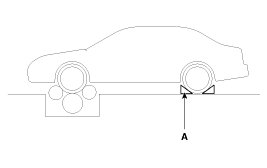
[km/h]
Velocity
(㎞/h)
|
Tolerance
(㎞/h)
|
20
|
+
3.5
+ 0.5
|
40
|
+
4.0
+ 1.0
|
60
|
+
4.7
+ 1.7
|
80
|
+
5.5
+ 2.5
|
100
|
+
6.0
+ 3.0
|
120
|
+
6.5
+ 3.5
|
140
|
+
7.5
+ 4.5
|
160
|
+
8.5
+ 5.5
|
180
|
+
10.0
+ 6.5
|
200
|
+
11.0
+ 7.5
|
220
|
+
12.0
+ 8.5
|
240
|
+
13.0
+
9.5
|
[mph]
Velocity
(mph)
|
Tolerance
(mph)
|
20
|
+
2.5
+ 0.5
|
40
|
+
2.5
+ 0.5
|
60
|
+
3.5
+ 1.5
|
80
|
+
3.5
+ 1.5
|
100
|
+
5.0
+ 3.0
|
120
|
+
7.2
+ 4.8
|
140
|
+
8.2
+ 5.8
|
150
|
+
9.2
+
6.8
|
|
Tachometer
| 1. |
Connect the GDS to the diagnostic link
connector or install a tachometer. |
| 2. |
With the engine started, compare the readings
of the tester with that of the tachometer. Replace the tachometer if
the tolerance is exceeded.
| 1. |
Reversing the connections of the
tachometer will damage the transistor and diodes
inside. |
| 2. |
When removing or installing the
tachometer, be careful not to drop it or subject it to
severe
shock. | |
Revolution
(rpm)
|
Tolerance
(rpm)
Max
8000rpm
|
Gasoline
|
1,000
|
±100
|
2,000
|
±100
|
3,000
|
±100
|
4,000
|
±100
|
5,000
|
±100
|
6,000
|
±100
|
7,000
|
±100
|
8,000
|
±100
|
|
Fuel Gauge
| 1. |
Disconnect the fuel sender connector from the
fuel sender. |
| 2. |
Connect a 3.4 watt, 12V test bulb to terminals
1 and 3 on the wire harness side
connector. |
| 3. |
Turn the ignition switch to the ON, and then
check that the bulb lights up and the fuel gauge needle moves to
full.

|
Main Fuel Gauge Sender
| 1. |
Using an ohmmeter, measure the resistance
between terminals 1 and 3 of sender connector (A) at each float
level.
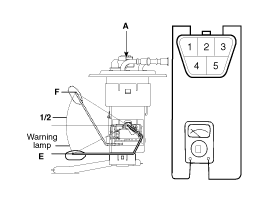
|
| 2. |
Also check that the resistance changes
smoothly when the float is moved from "E" to "F"
Segment
|
Position
|
Resistance
(Ω)
|
12
|
Sender
(F)
|
15 ±
2
|
6
|
1/2
|
66.2 ±
2
|
1
|
Warning lamp
|
156 ±
2
|
1
|
Sender
(E)
|
200 ±
3
|
|
| 3. |
If the height resistance is unsatisfied,
replace the fuel sender as an assembly.
|
After completing this test, wipe the
sender dry and reinstall it in the fuel
tank. | |
Brake Fluid Level Warning Switch
| 1. |
Remove the connector (A) from the switch
located at the brake fluid
reservoir. |
| 2. |
Verify that continuity exists between switch
terminals 1 and 2 while pressing the switch (float) down with a
rod.

|
| 3. |
If continuity is not as specified, replace the
brake fuild level warning switch. |
Brake Fluid Level Warning Lamp
| 2. |
Release the parking
brake. |
| 3. |
Remove the connector from the brake fluid
level warning switch. |
| 4. |
Ground the connector at the harness
side. |
| 5. |
Verify that the warning lamp
lights. |
Parking Brake Switch
The parking brake switch
(A) is a pulling type. It is located under the parking brake lever. To
adjust, move the switch mount up and down with the parking brake lever
released all the way.
| 1. |
Check that there is continuity between the
terminal and switch body with the switch ON (Lever is
pulled). |
| 2. |
Check that there is no continuity between the
terminal and switch body with the switch OFF (Lever is
released).
If continuity is not as specified, replace the
switch or inspect its ground connection.
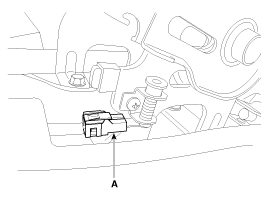
|
Door Switch
Remove the door switch
and check for continuity between the terminals.
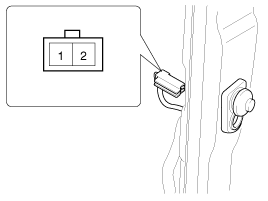

Seat Belt Switch
| 1. |
Remove the connector from the
switch. |
| 2. |
Check for continuity between
terminals.
Seat belt
condition
|
Continuity
|
Fastened
|
Non-conductive (∞Ω)
|
Not
fastened
|
Conductive (Ω)
|
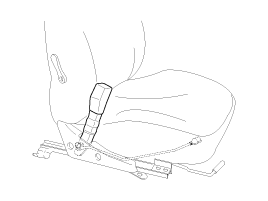
|
Seat Belt Warning Lamp
With the ignition switch
turned ON, verify that the lamp glows.
Seat belt
condition
|
Warning lamp
|
Fastened
|
OFF
|
Not
fastened
|
ON
|
| 1. |
Disconnect the negative (-) battery
terminal. |
| 2. |
Remove the upper shroud(A) with moving down
the steering wheel.
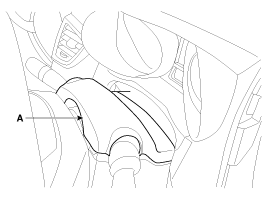
|
| 3. |
Remove the cluster fascia upper panel (A).

|
| 4. |
Remove the cluster(A) after loosening 4 screws
and disconnecting a connector(B).

|
| 1. |
Install the cluster to the crash
pad. |
| 2. |
Install the upper
shround. |
| 3. |
Install the cluster fascia upper
panel. |